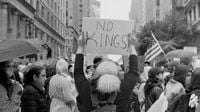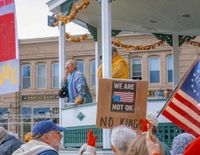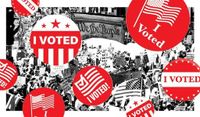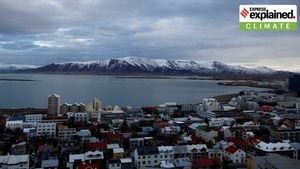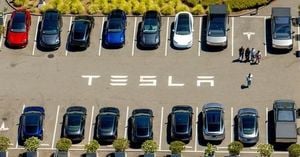Last weekend, an estimated seven million Americans took to the streets in cities across the country for the massive "No Kings" protest—an event that is already being hailed as one of the largest single-day demonstrations in U.S. history. The rallies, held on October 18 and 19, 2025, were a spectacle of color and creativity, with participants donning costumes ranging from Uncle Sams and Lady Libertys to frogs, all in a bid to counter the narrative that the protests would devolve into violence and chaos.
According to Politico, the sheer size and vibrancy of the crowds defied the dire warnings that had circulated in the days leading up to the event. Instead of the "violent criminals" and "Hamas terrorists" some critics had predicted, the streets were filled with people carrying signs addressing a spectrum of urgent issues—attacks on abortion rights, former President Trump’s connections to Jeffrey Epstein, and his close relationships with billionaires, tech moguls, and leaders in the fossil-fuel industry. The protest was overwhelmingly peaceful, a fact that many organizers and participants were eager to highlight.
Yet, even as the majority of demonstrators celebrated their ability to gather and make their voices heard without incident, there were troubling reports of violence—this time, not from the protesters, but from law enforcement. At a "No Kings" protest in California, the Los Angeles Police Department (LAPD) was accused of hitting a protester with a vehicle and firing less lethal ammunition at reporters who were covering the event. As Knock LA reported, these actions came just days after the LAPD had sought to overturn an injunction that prevented them from using force against journalists. The city council, in a unanimous vote on October 17, 2025, halted City Attorney Hydee Feldstein Soto’s attempt to lift that injunction, and the motion was withdrawn the same day. Nevertheless, eyewitness accounts indicated that some officers still targeted journalists, raising questions about the effectiveness of legal protections for the press.
Adam Rose, press rights chair at the Los Angeles Press Club, minced no words in a statement to LAist: “Karen Bass is quick to run to the media for attention to criticize Trump for violating court orders (rightfully so!), but when the media is assaulted by her own LAPD, she never says a word… Instead of holding the department accountable, the city is spending even more money to hire an outside law firm so they can effectively beg a judge for permission to keep assaulting journalists for just doing their job. The mayor of Los Angeles needs to take charge here, and Bass has been completely absent.”
This tension between demonstrators and law enforcement is nothing new, but it has taken on renewed urgency as Americans grapple with the rapid-fire policy changes emerging from the federal government. For months, citizens have rallied against National Guard deployments, ICE arrests, Supreme Court rulings, and even mass layoffs at major companies. The "No Kings" protest, however, marked a turning point—both in terms of scale and the breadth of issues addressed.
Climate activists, in particular, have found themselves at a crossroads. The swift reversal of climate policies by the current administration has left many environmentalists reeling. Erich Pica, president of Friends of the Earth, told Politico, “What we are facing right now is the evisceration of 60 years’ worth of environmental progress and a crisis of confidence within the environmental and climate communities. Folks are kind of spinning about what is happening and how to address it.”
Despite these setbacks, many climate groups are recalibrating their strategies. The youth-led Sunrise Movement, which rose to prominence in 2018 with a sit-in at then-House Speaker Nancy Pelosi’s office, has broadened its focus to include protesting authoritarianism. Stevie O’Hanlon, the group’s communications director, explained, “Our mission remains the same. We’re trying to win bold climate action that needs to scale the crises we face and improve the lives of working people. But that’s not going to be possible unless we take on the threat right in front of us.” O’Hanlon added that the impacts of administration policies are being felt acutely on college campuses, where students risk expulsion for speaking out. “If you cannot protest, if you cannot speak out, if students are getting expelled for raising their voices because administrators want to please the Trump administration, those are not the conditions in which we’re going to successfully be able to organize a movement of young people to fight for a Green New Deal,” she said.
Older generations are also joining the fight. Third Act, a climate action group for those over 60, recently organized "Sun Day" on the fall equinox, celebrating solar energy’s potential. Bill McKibben, the group’s founder and a renowned climate activist, has urged members to focus on rolling out renewable energy quickly enough to slow global warming. In his newsletter, McKibben emphasized, “Show up—right now that’s our best way to keep building the opposition.”
Other organizations, like Stand.earth, have doubled down on protest. Todd Paglia, the group’s executive director, told Politico, “We’ve been sued for hundreds of millions of dollars. We’ve had our offices invaded. We get death threats on a regular basis, like that’s just normal for us. And so this is a time to go full tilt and to push back on what the administration is doing.” Stand.earth has focused its efforts on holding business and banking sectors accountable, particularly technology companies like Microsoft, which activists argue have reneged on climate commitments since Trump returned to office.
Protesters, however, face mounting risks—not just from potential arrest, but from increasingly sophisticated surveillance. Matthew Guariglia, a senior policy analyst at the Electronic Frontier Foundation, told Politico, “It is so easy to scoop up a tremendous amount of data, and the vector along which they collect that data is usually somebody’s political expression. AI has enabled centralization and consolidation of data in a way that we’ve never seen before.” Guariglia pointed to the history of surveillance against activists, from the eco-terrorist panic of the 1990s to the monitoring of the Dakota Access Pipeline protests in 2016, when private security and police used social media scanning and cell phone geo-location to track demonstrators.
Despite these challenges, many activists remain undeterred. O’Hanlon said Sunrise Movement now encourages members to attend larger protests to avoid being singled out, while Paglia advises BIPOC volunteers to exercise extra caution. Guariglia advocates awareness: “You have to be realistic about what police have done historically and what they are technically capable of doing. I think everybody should protest. I think it is about finding your ways of expressing yourself that are most reasonable. And part of how you assess that is by having a knowledge of the surveillance landscape.”
As the dust settles from the "No Kings" protest, the conversation is shifting. The focus is no longer just on whether protests remain peaceful, but on the broader context of law enforcement’s role, the resilience of civil society, and the evolving tactics of activists determined to keep fighting for their causes—no matter the obstacles in their path.
